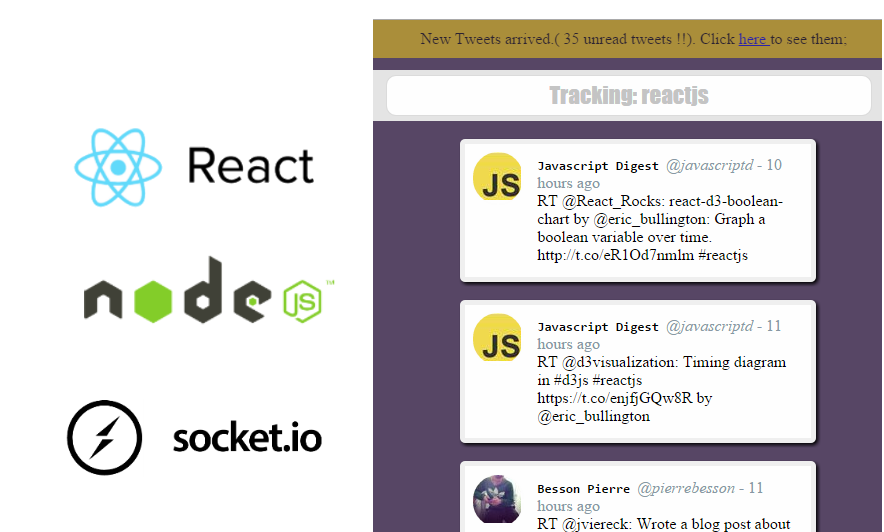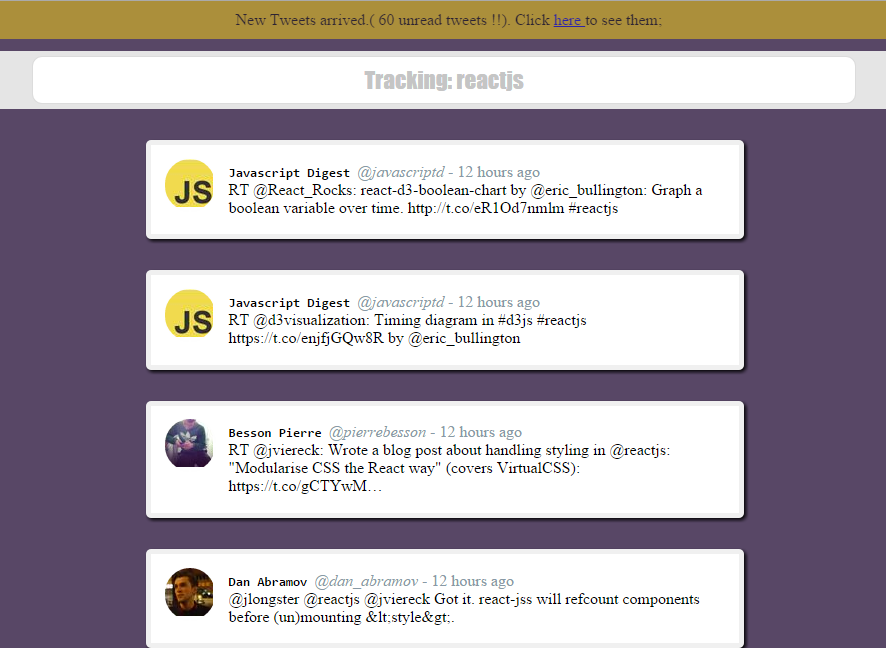With the news of facebook launching react-native, i couldn’t stop myself from learning ReactJS.
Earlier than that, i often ask myself this question on a thought of learning new javascript frameworks : Why do i need to learn one more?.
Wel, News of react-native pique my interest and forced me to step out of my comfort zone. I fire up the browser with ignited spirit to devour ReactJS. (:
First Impression
With a background of MVC taught by backbone and angularjs, reactJS was totally new. ReactJS is V in MVC . I then thought how’s it different from angularJS Directive or ember components?
I also got confused by one-way reactive data flow. What does it mean? Data often moves from back & forth. ReactJS uses virtual DOM. So, how is it useful?
Without mulling over it much, i decided to build an RealTime application using it and when it comes to realTime twitter live feed often comes into mind.
So, i made Realtime status tracking application using ReactJS: http://track-tweets.herokuapp.com/. It took me only two days ( need not to forget i go to office in day time) to built this application.

Feature list:
- Show tweets on page load (render at server side)
- As user scroll down and reach near bottom, more tweets appends from mongoDB powered database (lazy loading)
- As new tweets show up on twitter matching track string, user get realtime notification about it
Please find source code on github: sahilsk/track-tweets

In this post, i want to share my views on facebook ReactJS.
NOTE: Views are totally personal and has nothing to do with organization, people or girls i might be connected to..
Small learning Curve
Well, having removed M and C from MVC you’re left with only V to learn and that is ReactJS. So, learning curve is drastically reduced. In couple of minutes you can get started and rest you can learn as you go.
There getting started guide incredibly simple. Why incredible? because i didn’t trust it and take google help to search more advance ReactJS tutorials. You can save time if you stick with it( though googling won’t harm either).
You don’t need to learn about providers, service , factory or any more jargons you may have seen in other frameworks.
Tidy manageable code
In writing realTime application code often go messy. In reactJS components help you organize your code by allowing you to divide big application into smaller component.
For my application here the application components when put together look like:
/react/components/tweetApp.react.js
---
render: function(){
return (
<div className="tweetApp_wrapper" >
<Tracker track={this.state.track} />
<Tweets tweets={this.state.tweets} />
<Notification count={this.state.unreadTweets.count}
showUnreadTweets={this.showUnreadTweets}
/>
<Loader loading={this.state.loading} />
</div>
)
}
---
Cool stuff
ReactJS Virtual DoM render the whole DOM in memory first and then push only the diff into the browser one. It not only make browser rendering fast, but also enable you to render the DOM at server side. Cool isn’t it?
In my application when page open up it’s ReactJS server side rendered components that you see.
As shown in the snippet below renderToString method render component as string which i’m passing to my expressJS index view template.
/server/routes/index.js
---
var markup = React.renderToString( TweetApp( {"tweets": tweets } ) );
res.render("index",
{ "layout": '../../server/views/layouts/main',
"tweets": JSON.stringify(tweets),
"markup": markup
} );
---
Why is it important? Well, i care for my website reachability. So, i care about it SEO. Though google crawler interpret javascript, you still have to rely on third party services like prerender.io or phantomJS to boost your SEO.
What next?
Facebok react-native: React Native enables you to build world-class application experiences on native platforms using a consistent developer experience based on JavaScript and React.
At the time of writing this article react-native supports only iOS.
Facebook Flux: application architecture bolstering uni-directional flow in applications.
Facebook Flow : Adds static typing to JavaScript to improve developer productivity and code quality. http://flowtype.org/
…and hopefully more in future. Be hopeful please…
Conclusion
ReactJS, Flux & Flow are more about philosophical expect of development rather than learning few more technical jargons terms. phew…
My new year resolution is to learn more on ReactJS, REACT-Native, flux & flow.
Source code: sahilsk/track-tweets